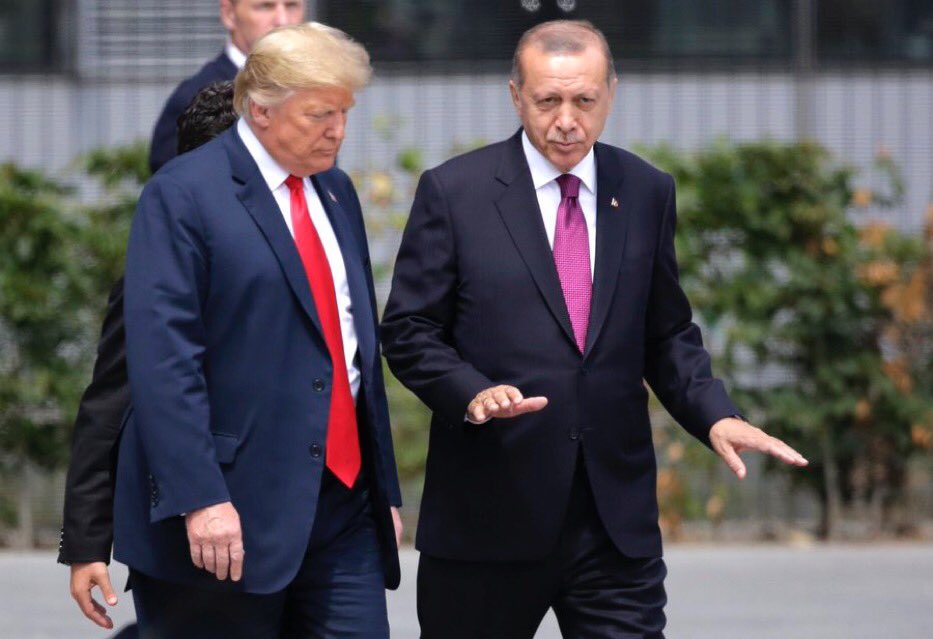Since Trump’s withdrawal announcement, talks have been launched between Ankara and Washington, including calls between Trump and Erdogan and discussions between the Turkish Chief of Staff, Yasar Guler, and his American counterpart Joseph Dunford in Brussels, a few days before meetings between National Security Adviser John Bolton and Dunford in Ankara.
Mevlut Cavusoglu is continuing the discussions by meeting his American counterpart Mike Pompeo on Feb. 6, 2019, after high-level officials in the two countries hold talks in Washington the day before. On Wednesday, Erdogan is also briefing his Russian counterpart, Vladimir Putin, in Moscow on the results of the discussions with the Americans.
According to reports, the tripartite talks are considering the following issues:
First: The depth of the zone. Ankara wants the “security zone” to extend 32 kilometers into northern Syria with a length of 460 km from Jarablus to Iraqi Kurdistan (the Syrian-Turkish border is 900 km). Washington has agreed in principle to 10 km. Moscow has proposed that the depth range between five and 10 km, while the head of the Kurdish People’s Protection Units (YPG), Siban Hamou, has demanded that the zone be on the Turkish side of the border. Ankara wants its armed forces to have the right to enter a depth of 32 km—that is, more than that permitted by the 1998 “Adana agreement” between Damascus and Ankara.
Second: Protecting the zone, and its name. Turkey wants the zone to be “safe,” that is, to include a no-fly zone. However, Moscow accepts a “buffer zone” without a no-fly zone. The Kurds meanwhile demand a “no-fly zone” to protect them from Turkey. The French have promised to remain in eastern Syria after the American withdrawal, but there are difficulties if the International Coalition does not maintain a no-fly zone and the al-Tanf base, as well as the deconfliction agreement with Russia.
Third: The presence of the Syrian state. Ankara is sticking to its rejection of any presence by Syrian government forces. Officials say that if there are government forces, they will cooperate with the Kurds, and the attacks by the Kurdistan Workers’ Party against southeastern Turkey will continue.
Ankara proposes deploying Peshmerga forces from Iraqi Kurdistan, while Moscow proposes deploying government forces on the border within the principle of Syrian sovereignty. Multiple Russian officials said that the government should deploy in place of the American forces. For their part, the Kurds have submitted documents to Moscow and Damascus proposing the deployment of the Syrian army on the border and joint cooperation against Ankara.
Fourth: The Kurds. On Dec. 23, 2018, Trump called Erdogan to ensure “protection for the Kurds” after the American withdrawal. Bolton also warned against an attack on the Kurds, which angered Erdogan. Ankara says that the People’s Protection Units (YPG) do not represent all Kurds, while Moscow is insisting on reaching arrangements that guarantee the interests and protect both Turkey and the Kurds. The YPG fear that the safe zone will put majority Kurdish areas such as Ayn al-Arab (Kobani) and Ras al-Ayn (Sere Kaniye) under Turkish influence. Ankara proposes that the area be cleared of “any terrorist presence” and then internal security forces will be formed to ensure stability, in coordination with the Turkish army.
Fifth: The zone’s administration. Ankara proposes forming local councils free from figures with YPG ties. Moscow agrees to the formation of local councils with the ethnic majority of each area represented in the local council, while the Kurds say that the councils in the eastern Euphrates area are elected by locals.
Sixth: Relations of the areas to the center. Ankara wants measures and arrangements to keep this area out of direct state control, while Moscow is sticking to its support for Damascus to return full government control to these areas. The Kurds propose acknowledging the Self-Administration and cooperation in natural resources and a program of incorporating the YPG and the Syrian Democratic Forces into the national army.
Arrangements
It is believed that the possible deals between Moscow and Ankara could be decisive for the future of the buffer zone and the eastern Euphrates. In accordance with their previous agreements, Turkey established the Euphrates Shield area between Jarablus and al-Bab north of Aleppo at the end of 2016 and took control of Afrin at the beginning of 2018, as well as the de-escalation zone in Idleb in September 2018, which comprises a “buffer strip” in northern Syria extending from Jarablus to Lattakia. Twelve Turkish observation points have also been deployed in the Idleb countryside, reaching a point near northern Hama, deep inside Syria.
If the tripartite American-Russian-Turkish arrangements are successful, Ankara will have a buffer zone extending from Kasab on the Mediterranean to Faysh Khabour in eastern Syria, which will make this a zone of influence, severing the Kurdish entity and isolating the Kurds of northern Syria from the Kurds of southern Turkey after Ankara successfully isolated the Kurds east of the Euphrates, preventing them from having any path to the Mediterranean.
This article was translated and edited by The Syrian Observer. Responsibility for the information and views set out in this article lies entirely with the author.


